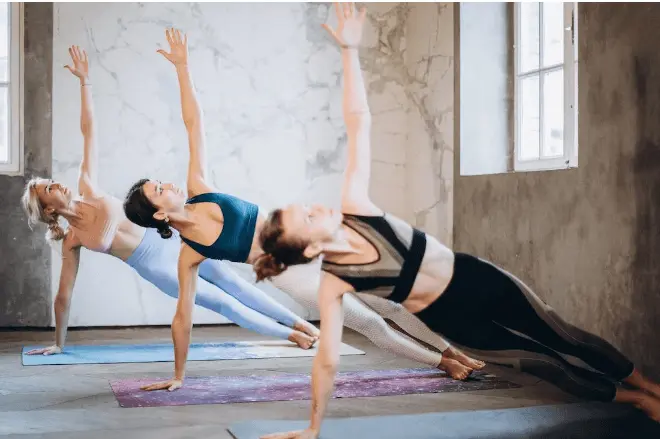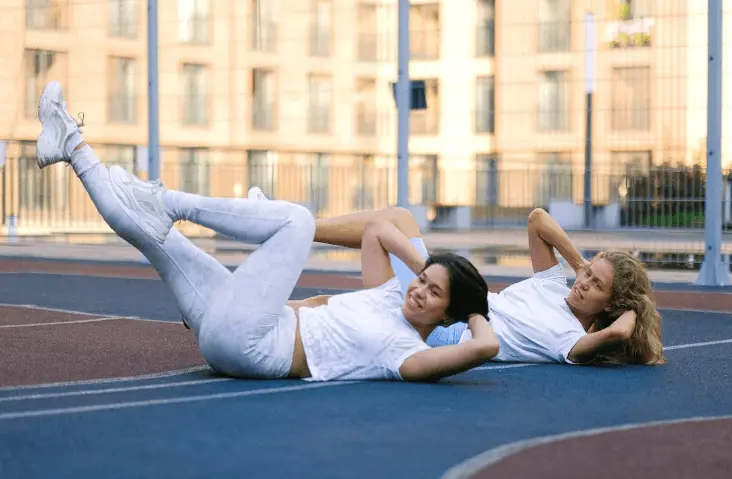The crunch is a typical core exercise. It is a special exercise for your abdominal muscles, rectus abdominis, and the six-pack muscle. This exercise helps you in building a “six-pack” along with tightening your core. Crunches can be a part of your core-strengthening workouts or as a part of your whole-body exercises.
Though crunches have been the most popular ab exercise for decades, it is not safe for everyone. Besides being an important exercise in workouts primarily focusing on the core and abs, they can lead to injuries. It can cause a lot of stress in your neck and back.
We got you the A-Z guide on crunches. In this article, you will learn about how to do a crunch, its pros and cons, variations of crunches, safety tips and some of the common mistakes people make while doing crunches.
Benefits of doing crunches
Doing crunches comes with many benefits. Crunches are an ideal exercise for almost all beginners. Moreover, as a beginner, you might not have access to equipment. In such a case, crunches can be done anywhere as a bodyweight exercise.

As they exclusively work your abs, they are your go-to if you aim for a six-pack. The Rectus abdominis is one of the major core muscles, it gives your body the required stability.
Crunches also help you with trimming down your waist. We all can collectively agree that a strong core and back are exceptionally crucial for your athletic performance as well as your daily basis movements. Additionally, a strong core is a foundation to prevent back pain.
Disadvantages of crunches
Even though the crunch has numerous benefits, it also comes with a few disadvantages. It is necessary to consider both advantages and disadvantages before trying it.
A disadvantage is that the crunch focuses only on the abs. It does not involve obliques or any other core muscles. It does strengthen your core (mostly the abs). However, if you wish to improve your core as a whole then this exercise might not be the best.
Crunches flex the spine and this may put pressure on your neck and back. This can cause injuries in these areas. For this reason, we do not suggest older adults do this move. Specifically, people who have had neck or back injuries or have issues related to these areas better avoid doing crunches.
How to do a crunch?
Basic crunches are done on the floor. You can do it on a yoga mat to make it seem more comfortable.
- Lie down on your back. Place your feet on the ground hip-width apart.
- Now, bend your knees and place your arms across the chest.
- Tighten your core and inhale.
- Exhale as you lift your body. Keep your neck and head relaxed.
- Inhale and return to the starting point.
You can perform up to 20 reps but maintain the perfect form in each of the repetitions.
Safety Tips
- If you feel this is straining your neck, you can put your hands behind your head and gently cradle your head with your fingers.
- Use only your core to raise your body. If this movement comes from your neck or head, it may increase the risk of injury.
- Go slow and control your movement to engage the right muscles.
Variations of a basic crunch
Once you master the classic crunches exercise and perfect the form, you can try this exercise in various ways, depending upon your fitness level and your goal.
Bicycle crunch
The bicycle crunch is a variation of the regular crunch. It helps you work your hips, obliques and rectus abdominis.
- Lie down on your back and bend your left knee towards your chest. Slightly lift the right leg off the floor keeping it straight.
- Place your hands behind your neck.
- Now, lift the right shoulder off the ground and move the right elbow toward the left knee.
- Extend the left leg and bend your right knee towards the shoulder while you bring back your right shoulder to the ground.
- Lift the left shoulder and move the left elbow towards the right knee.
- Perform 3 sets of 12 reps each.

Exercise ball crunch
This is an intermediate-level exercise. Be sure to do it slowly and focus on your balance.
- Lie on an exercise ball with the back curvature pressed against the ball.
- Bend your knees with your feet flat on the floor.
- Keep your hand crossed over your chest or alongside your body. (This can help prevent neck strains).
- Lower the torso into a stretching position.
- Engage your core. Now, crunch your ribs toward the pelvic bones by contracting your abdominal muscles.
- Hold the crunch for a few seconds.
- Slowly lower back down over the ball.
Reverse crunch
We can say this is some sort of an extra challenge for you.
- Start by lying down on your back with your arms beside you.
- Raise your legs. Your thighs should be perpendicular to the ground.
- Bend your knees at 90 degrees.
- Contract your abs while breathing out and bring your knees towards your chest by raising your hips off the ground.
- Hold the position for a moment.
- Now, slowly lower your legs back to the beginning position.
It is important to move slowly as this can prevent you from straining your lower back. Make sure to not arch your back.
Common mistakes
Crunches are not as simple and easy as they seem. But it does have its complexities. Avoid the below mistakes while doing crunches.
- Crunching high: Crunches are done with subtle movement by lifting your shoulders only a few inches above the floor. Avoid crunching too high or jerking your shoulders up as this can not be effective.
- Straining your neck: pulling on the neck will strain your neck and it won’t work your abs. Movement in your abs must be seen and not from your head.
- Relaxing your shoulders: don’t let your shoulders fall onto the floor. Keep your core engaged throughout the movement. Avoid relaxing your shoulders on the floor.
- Back: more than keeping a flat back against the floor, it is better to keep a neutral spine. If you arch your back, your abs can take time to build strength.
Other exercises you may try
The following exercises are safer and better alternatives for crunches that you may try. They have a lesser risk of injury. On top of that, these exercises work on other major abdominal muscles and not just the abs.
Bird dog
Bird dog is a beginner-level core strengthening exercise. While this elbow-to-knee variation of the same works your core along with your back and abs.
- Stand on all four. placing your hands below your shoulders and knees below your hips.
- Tighten your core and lift your right leg to hip level while straightening it. Simultaneously, extend the left arm to shoulder level.
- Bring your right knee and left arm towards each other. Now, return to the starting position.
- Do 1 set of 8 to 12 reps and repeat on the opposite side.
Mountain climber
Mountain climber makes it to most of the ab workouts.
- Get into a plank position. Make sure to distribute your weight throughout your body evenly.
- Keep your hands shoulder-width apart, back flat and head in alignment.
- Tighten/engage your core.
- Pull your right knee in towards your chest as far as you can.
- Now, switch to the other leg. Pull out your right knee and bring your left knee in.
- Move your knees in and out as fast and as far as you can.
- Inhale and exhale with each leg change.
- Remember to continue breathing. Do not hold your breath.
Side plank rotation
Plank is one of the basic ab exercises. This advanced variation of a basic plank strengthens your obliques, arms and shoulders.
- Lie down on the right side with your right forearm under your shoulder. Extend your legs and place your right foot beneath the left foot.
- Tighten your core.
- Lift your hips and raise your left arm straight.
- Now, rotate your torso toward the floor and bring the left arm under your body.
- Rotate your torso again while straightening the left arm to return to the starting position.
- Perform one set with about 10 reps.
- After that, repeat on the opposite side.

Conclusion
Crunches are the classic benchmark for ab workouts. However, it can not be considered a functional core workout. As we have seen, they can be harsh on your back and neck risking their injuries. There are a chance crunches can compress your neck and spine.
If you would like to do this exercise during your pregnancy, strictly avoid it after the first trimester. Its alternatives are multiple folds better than the basic crunches as they are not only safer but also engage more muscles than a crunch.
If you would like to include crunches in your workouts, we suggest you consult a trainer or a fitness expert. Better do it under their supervision as they can give you the right advice and keep you safe and make use of this ab exercise to its best.
